Ghana. Sacred Golden Stool.
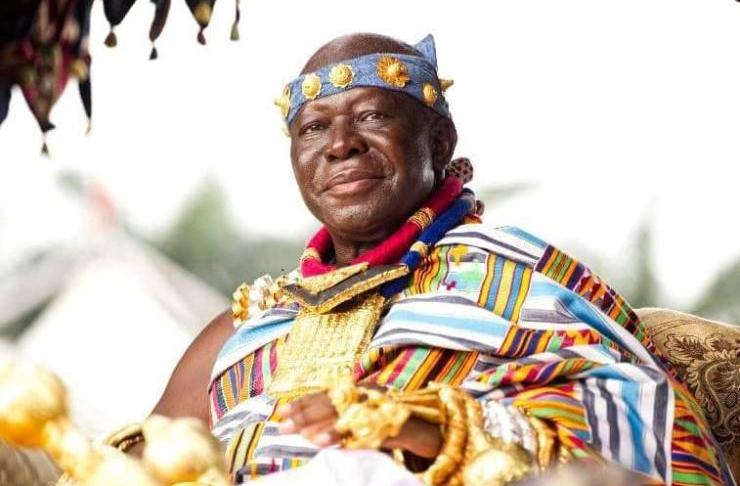
The most important and sacred Asante stool is the ‘Golden Stool’. It represents the authority of the Asantehene (king), enshrines the soul of the nation, and symbolizes the kingdom’s unity.
Among the Asante and other Akan peoples, stools play an important role in each person’s life. When children learn to crawl, they receive stools as their first gift from their father. For young women, puberty rites entail sitting on their stools. A husband presents his wife with a stool when they marry. A deceased person is bathed on a stool before burial. Ceremonial stools are blackened and enshrined after the death of an important leader, an illustration of stools’ ability to represent a person’s soul.Not only are stools ever-present in the lives of Asante peoples, but their basic form also remains constant. All Asante stools, whether for domestic use or public display, are carved from a single block of wood.
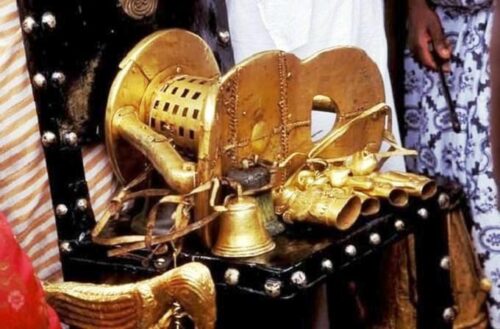
‘The Golden Stool’ also known as “Sika Dwa Kofi” (believed to be born on Friday) symbolises the kingdom’s unity. Photo: The Kingdom of Asante/Facebook
The seat is typically curved and supported over a rectangular base by a central column and four corner posts. The midsection may be geometric or figurative, but the styles used on ceremonial stools represent associated proverbs.
State or ceremonial stools are the most important of all Akan royal regalia. Only chiefs and high-ranking officials are given the Asantehene’s (Asante King) permission to have their stools decorated with strips of intricately patterned silver or gold. Silver was only accessible through trade, often in the form of silver European coinage that was melted down.
The most important and sacred Asante stool is the ‘Golden Stool’. It represents the authority of the Asantehene (king), enshrines the soul of the nation, and symbolises the kingdom’s unity.
Made of solid gold, the Golden Stool never touches the ground; it is carried in procession and has its own throne.
The Symbol of Power
‘The Golden Stool’ also known as “Sika Dwa Kofi” (believed to be born on Friday) is the royal and divine throne of kings of the Asante people of central Ghana. The stool which is believed to house the spirit of the Asante nation is considered to be so sacred that no one is allowed to sit on it. The Golden Stool has been the symbol of power in Asante Kingdom since the 17th century.
The Stool is made of pure gold and hung with bells to warn the king of impending danger. The stool, which also has its own throne is so sacred that it is kept under the strictest security and is taken outside only on exceptional occasions. It stands 18 inches high, 24 inches long, and 12 inches wide. It was never allowed to touch the ground.
Its entire surface is inlaid with gold and hung with bells to warn the king of impending danger.
Each new Asante king is lowered and raised over the Golden Stool without touching it. No one could be considered a legitimate ruler without the Golden Stool, which usually occupied its own throne next to the Asantehene (King of the Asantes).
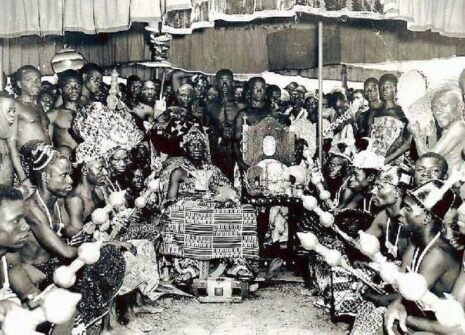
Otumfuo Agyemang Prempeh II sitting in the state next to the Golden Stool (1935). Photo: Asante Nation/Facebook
According to Asante oral history, the golden stool descended from the sky through the chants of one of their greatest traditional priests known as Okomfo Anokye, who is one of the two chief founders of the Asante Confederacy. It landed on the lap of the first Asante King, Nana Osei Tutu I, thereby designating him Asantehene Osei Tutu I, king of all the chiefdoms he had conquered. He used that to unify the people in the 17th century. The priest then ordered the chiefs of the formerly independent states to bury their existing regalia to signify their loyalty to the supreme Golden Stool. Beginning with Osei Tutu I, the Asantes believed that the Golden Stool houses the soul of the Asante nation – living, dead and yet to be born.
Prior to the establishment of the Asante kingdom, Akan people were organised in small independent States, each headed by a paramount chief. Around 1701, in the city of Kumasi, several of these States united under the military and economic strength of the Asante.
By the 19th Century, the Asantes began a series of clashes with the British Empire which had established effective control of the coastal region of what is now Ghana. They fought three Anglo-Ashanti Wars between 1824 and 1874, with the British and their African allies gaining more control over Ashanti Territory. During the fourth Anglo-Ashanti War, the British and their Indian and African allies defeated Asantehene Agyeman Prempeh, eventually capturing him and sending him into exile in the Seychelles Islands.
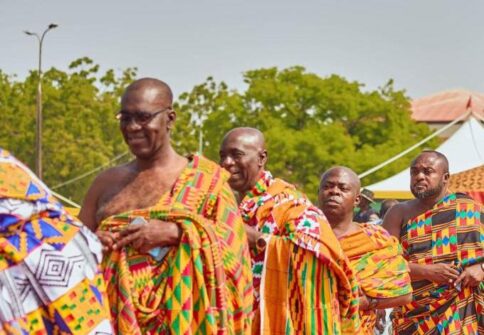
The king’s dignitaries. Photo: The Kingdom of Asante/Facebook
The final war (1900), essentially a rebellion led by Yaa Asantewaa, the Queen Mother and Gate Keeper of the Golden Stool, was prompted by the demand by Sir Frederick Mitchell Hodgson, the British Governor of the Gold Coast to sit on the Golden Stool. With his remark, Yaa Asantewaa led a rebellion called the Word of the Golden Stool which began on March 28, 1900.
The intense fighting led to the death of more than 2,000 Asantes and 1,000 British and Allied troops. Both totals were higher than the deaths from all previous Anglo-Ashanti wars combined. The war ended, however, after six months.
Yaa Asantewaa was captured by the British in 1901 and quickly exiled to the Seychelles, where she died in 1921, but the British never captured the Golden Stool. Hidden by the Ashanti, it was discovered by a group of African railroad builders in 1920. They stripped it of its gold ornaments and were tried by the Ashanti and sentenced to death.
British colonial authorities intervened, however, and they were exiled from the Gold Coast Colony.
After realising the importance of the Golden Stool to the Asantes, the British gave assurances that they would never interfere with it again. Restored to its ceremonial place, the Golden Stool had continuously been used in rituals crowning the Asantehene, although he is now considered a traditional ruler without political power or influence. Nonetheless, the Golden Stool remains a cherished symbol of the former Ashanti Empire.
On the right side of the king
The Asantes had always maintained the Golden Stool as their most prized possession. Before they went to war, their war chiefs consulted it. As time progressed and as the Ashanti scored more victories over their rivals, turning their kingdom into an empire, the Golden Stool became even more revered.
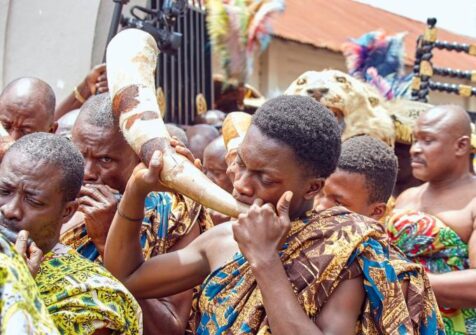
In the Akwasidae festival, the Golden Stool is displayed at the palace grounds in the presence of the king while people sing and dance. Photo: The Kingdom of Asante/Facebook
The Golden Stool is usually placed on the right side of the king, and it is only brought out when a new Asante king is to be the inaugurated, during the commemoration of the date the Golden Stool fell down from Heaven, and Akwasidae (the festival of the Asantes).
On this day (Akwasidae festival), the Golden Stool is displayed at the palace grounds in the presence of the king while people sing and dance. Ritual libations of blood and schnapps (liquor) are also poured onto the thrones of the former kings as offerings to them and to the ancestors.
In Asante, all chiefs have a symbolic replica of the stool, and each has a different symbolic meaning for the person whose soul it seats. The Asantes have always defended the Golden Stool when it was at risk.(Open Photo: The 16th Asantehene, King of Ashanti, Otumfour Osei Tutu II. The Kingdom of Asante)
Damian Dieu Donne Avevor



